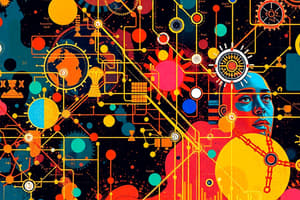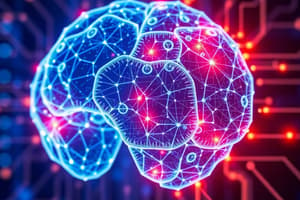Podcast
Questions and Answers
Which layer of a sociotechnical system includes physical components like servers and network devices?
Which layer of a sociotechnical system includes physical components like servers and network devices?
- People
- Hardware (correct)
- Data
- Software
The data layer only concerns itself with structured data and ignores unstructured data types.
The data layer only concerns itself with structured data and ignores unstructured data types.
False (B)
What is the primary goal of 'joint optimization' in STS design?
What is the primary goal of 'joint optimization' in STS design?
To simultaneously optimize the technical and social aspects of the system.
Shared values, beliefs, and norms within an organization are part of the __________ layer of a sociotechnical system.
Shared values, beliefs, and norms within an organization are part of the __________ layer of a sociotechnical system.
Match the following layers of a sociotechnical system with their descriptions:
Match the following layers of a sociotechnical system with their descriptions:
Which of the following is NOT a component of the software layer in a sociotechnical system?
Which of the following is NOT a component of the software layer in a sociotechnical system?
Data governance policies primarily focus on controlling the physical access to data centers.
Data governance policies primarily focus on controlling the physical access to data centers.
What is the purpose of 'minimal critical specification' in STS design?
What is the purpose of 'minimal critical specification' in STS design?
The __________ layer represents workflows, procedures, and tasks performed within a system.
The __________ layer represents workflows, procedures, and tasks performed within a system.
Which layer is most directly influenced by user interface design?
Which layer is most directly influenced by user interface design?
Organizational culture has no influence on the adoption of new technologies.
Organizational culture has no influence on the adoption of new technologies.
What potential issue arises from optimizing layers individually rather than collectively in a sociotechnical system?
What potential issue arises from optimizing layers individually rather than collectively in a sociotechnical system?
Ensuring compatibility between the technical and social subsystems is the essence of the __________ criterion within STS design.
Ensuring compatibility between the technical and social subsystems is the essence of the __________ criterion within STS design.
Resistance to change primarily affects which layer of a sociotechnical system?
Resistance to change primarily affects which layer of a sociotechnical system?
The 'structure' layer solely refers to the physical layout of hardware components.
The 'structure' layer solely refers to the physical layout of hardware components.
What is the role of IT governance frameworks within the structure layer of a sociotechnical system?
What is the role of IT governance frameworks within the structure layer of a sociotechnical system?
Using BPMN is a process for ensuring quality within the _______ layer of a sociotechnical system.
Using BPMN is a process for ensuring quality within the _______ layer of a sociotechnical system.
Which design principle emphasizes managing interactions between a system and its external environment?
Which design principle emphasizes managing interactions between a system and its external environment?
Within the context of sociotechnical system layers, what concept directly addresses the ethical implications of using AI in recruitment, encompassing considerations of fairness, transparency, and potential biases?
Within the context of sociotechnical system layers, what concept directly addresses the ethical implications of using AI in recruitment, encompassing considerations of fairness, transparency, and potential biases?
Considering the interdependencies within sociotechnical systems, what strategy would be most effective when addressing unintended consequences arising from the introduction of a new cloud-based data storage solution, impacting user workflows and data security protocols across various departments?
Considering the interdependencies within sociotechnical systems, what strategy would be most effective when addressing unintended consequences arising from the introduction of a new cloud-based data storage solution, impacting user workflows and data security protocols across various departments?
Flashcards
Sociotechnical System (STS)
Sociotechnical System (STS)
Interaction between technology and society, recognizing mutual influence.
Hardware Layer
Hardware Layer
Physical components, devices, and infrastructure of the IT system.
Software Layer
Software Layer
Programs that instruct the hardware, including applications and operating systems.
Data Layer
Data Layer
Signup and view all the flashcards
People Layer
People Layer
Signup and view all the flashcards
Process Layer
Process Layer
Signup and view all the flashcards
Structure Layer
Structure Layer
Signup and view all the flashcards
Culture Layer
Culture Layer
Signup and view all the flashcards
Application Software
Application Software
Signup and view all the flashcards
System Software
System Software
Signup and view all the flashcards
Middleware
Middleware
Signup and view all the flashcards
Data Governance
Data Governance
Signup and view all the flashcards
IT governance
IT governance
Signup and view all the flashcards
Optimization
Optimization
Signup and view all the flashcards
Minimal
Minimal
Signup and view all the flashcards
Criterion
Criterion
Signup and view all the flashcards
Study Notes
- A sociotechnical system (STS) involves the interaction between technology and society
- It recognizes that technology use shapes and is shaped by social structures
- STS considers organizational structures, processes, and human aspects alongside technology
Layers of a Sociotechnical System
- Hardware: Physical components, devices, and infrastructure of the IT system
- Software: Programs, applications, and operating systems that instruct the hardware
- Data: Facts, figures, and content processed and stored by the system
- People: Individuals who interact with the system (users, developers, operators)
- Processes: Defined series of actions or steps to achieve a specific outcome involving the IT system
- Structure: Organizational hierarchy and relationships that influence how the system is used and managed
- Culture: Shared values, beliefs, and norms that affect how technology is adopted and used
Hardware Layer
- Includes servers, workstations, network devices, and peripherals
- Performance characteristics like CPU speed, memory, and storage capacity are crucial
- Ensuring compatibility between hardware components is a key factor
- Physical security measures protect hardware from damage or theft
- Maintenance and upgrades are essential for long-term reliability
Software Layer
- Consists of application software, system software, and middleware
- Application software directly supports user tasks (e.g., word processors, CRM systems)
- System software manages and controls hardware resources
- Middleware enables communication and data management between different software applications
- Software development methodologies influence the quality and maintainability of software
- Software testing is vital to identify and fix bugs and vulnerabilities
Data Layer
- Encompasses the type, format, structure, and quality of data
- Databases are commonly used to store and manage structured data
- Data warehouses and data lakes store large volumes of data for analysis
- Data governance policies define how data is collected, stored, used, and protected
- Data security measures prevent unauthorized access, modification, or deletion
- Data analytics tools extract insights and patterns from data
People Layer
- Includes users, developers, IT support staff, and managers
- User training ensures effective and efficient system usage
- User interface design affects usability and user satisfaction
- Roles and responsibilities define how individuals interact with the system
- Communication and collaboration improve system development and operation
- Motivation and incentives can impact system adoption and usage
Process Layer
- Represents workflows, procedures, and tasks performed within the system
- Business process modeling techniques (e.g., BPMN) are used to document processes
- Automation of processes can improve efficiency and reduce errors
- Process optimization aims to streamline processes and eliminate redundancies
- Change management procedures control modifications to processes
- Monitoring and auditing ensure process compliance and effectiveness
Structure Layer
- Reflects the organizational hierarchy, reporting lines, and teams involved
- IT governance frameworks define roles, responsibilities, and decision-making processes
- Project management methodologies guide system development and implementation
- Outsourcing and partnerships involve external entities in the system
- Regulatory compliance dictates specific structural requirements
- Communication channels facilitate information flow within the organization
Culture Layer
- Represents shared values, beliefs, and norms that influence technology usage
- Organizational culture affects innovation, collaboration, and risk-taking
- Resistance to change can hinder the adoption of new technologies
- Security awareness training promotes responsible security practices
- Ethical considerations guide the development and use of IT systems
- Culture of continuous improvement encourages ongoing system refinement
Interdependencies and Interactions
- Layers are interconnected and influence one another
- Changes in one layer can have ripple effects on other layers
- Effective STS design requires considering these interdependencies
- Optimization of individual layers may not lead to overall system optimization
- Trade-offs between layers may be necessary to achieve specific goals
- Addressing unintended consequences across layers is critical
Importance of Sociotechnical Systems
- Helps understand the complexities of IT systems in real-world contexts
- Facilitates better decision-making regarding technology investments
- Improves system design by considering human and organizational factors
- Enhances user adoption and satisfaction with IT systems
- Reduces the risk of system failures and unintended consequences
- Enables proactive management of IT systems for long-term success
Challenges in STS Design
- Complexity of interactions between technical and social elements
- Difficulty in predicting human behavior and system usage patterns
- Conflicting goals and priorities among stakeholders
- Resistance to change from individuals or groups
- Ethical dilemmas related to data privacy, security, and bias
- Measuring the effectiveness and impact of sociotechnical systems
STS Design Principles
- Joint optimization: Simultaneously optimize the technical and social aspects of the system
- Minimal critical specification: Specify only the essential requirements, allowing flexibility
- Sociotechnical criterion: Ensure compatibility between the technical and social subsystems
- Boundary management: Manage the interactions between the system and its environment
- Information flow: Facilitate effective communication and information sharing
- Support systems: Provide resources and assistance to users and operators
Examples of STS Analysis
- Analyzing the impact of a new electronic health record system on hospital workflows
- Evaluating the implementation of a customer relationship management (CRM) system on sales team performance
- Assessing the security vulnerabilities of an online banking system from a human factors perspective
- Examining the social and ethical implications of using artificial intelligence in hiring decisions
- Understanding the role of technology in supporting remote work and collaboration
Studying That Suits You
Use AI to generate personalized quizzes and flashcards to suit your learning preferences.




